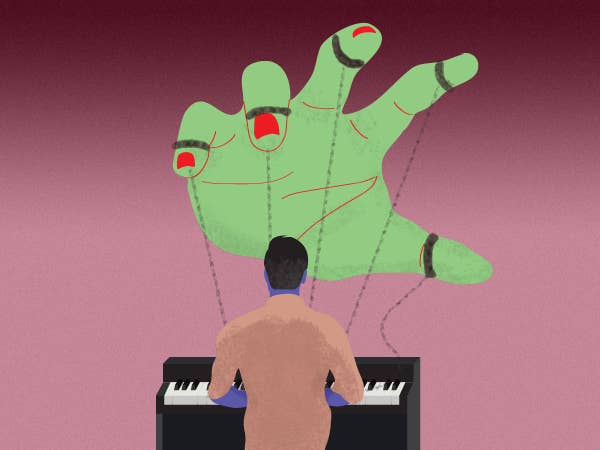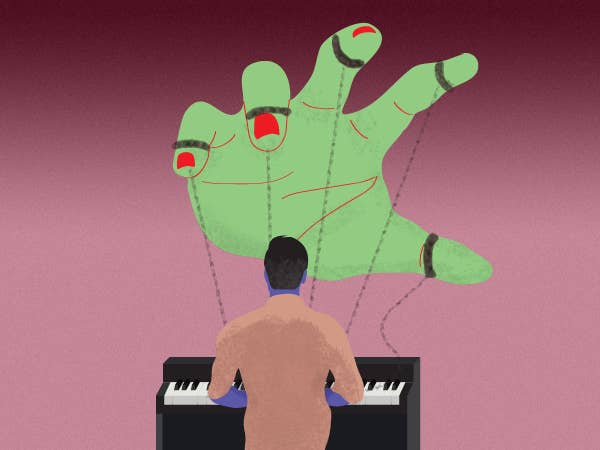

Image by Suede Jury
The leap from being a songwriter to pop artist usually results in a cataclysmic fall. For every Sia, Missy Elliott, or Bruno Mars, there are hundreds of contemporary songwriters whose dreams of stardom die on the vine.
They show up in New York, Los Angeles, and Nashville and find something other than the spotlight: a real, honest-to-god career. Nearly a million songwriters are registered with royalty-collecting agencies like BMI and ASCAP, but there are maybe a few dozen bankable pop acts at a given moment. It’s an insanely competitive world.
In 2016, music culture is schizophrenic. Surprise releases are subjected to a 24-hour news cycle. Huge albums get about a week to shine before fading into streaming discographies. A new artist has a short window to leave a mark, then they must immediately evolve. The next step often never comes.
Here lies the value of a great songwriter: the consistent ability to switch styles, to follow trends yet subvert them, to know, deep down, there’s a formula behind great pop music, and no matter how a song gets dressed up, the themes and emotions which bind us don’t change all that much.
Sinking revenues from the transition to streaming music has made the hunt for lasting hit records more competitive than it’s ever been. Pre-2000, writing a deep cut on a platinum album could buy you a new house. According to Tim “One Love” Sommers, a producer and songwriter who entered the industry’s upper echelon after penning B.o.B.’s smash “Airplanes” back in 2010, it’s all about home runs now. “Unless you have a big radio record or some big syncs, publishing really doesn’t generate that much money,” he said. “On Spotify, the master generates much more than the publishing rights. You have to be in pursuit of these big records if you want to make your living. I think that’s why songwriters are getting more and more into becoming artists. They realize, if you can build a brand, there’s so much more you can do. There are so many opportunities.”
Pre-2000, writing a deep cut on a platinum album could buy you a new house… it’s all about the home runs now.
I asked Emily Warren, a songwriter signed to Dr. Luke’s Prescription Songs imprint who is currently becoming a successful solo artist in her own right, what it’s like to blur the lines. “We all came from that place where we were doing our own thing,” she told me. “I don’t think anyone was born like, ‘I’m gonna write for other people.’ It became such an easy transition for me, because it’s so fun to get my own emotions out or sit with someone and help them communicate something that’s in their head. But I still have the bug in me where there are some songs that are about me where it doesn’t matter who cuts it. I have to sing it.”
For Jeremy Yohai, the vice president of A&R at Downtown Music Publishing, versatility when it comes to writing, performing and scoring—both in front of the camera and behind it—is the most appealing quality for an artist in 2016. “Songwriters that are artists and can also write for outside projects are the most interesting to work with on a creative and financial level,” he told me. “There are so many different conversations we can have with them. We can talk about working on their project, writing for another artist’s project, featuring on another artist’s song, or writing for ads, film and TV.”
Singer-songwriters are, of course, nothing new. Nat Hentoff, profiling Bob Dylan for the first time in The New Yorker in 1964, detailed why Dylan was such a unique threat compared to Joan Baez, his most obvious peer at the time. “Dylan’s impact has been the greater because he is a writer of songs as well as a performer,” he wrote. “Such compositions of his as ‘Blowin’ In The Wind,’ ‘Masters Of War,’ ‘Don’t Think Twice, It’s All Right,’ and ‘Only A Pawn In Their Game’ have become part of the repertoire of many other performers, including Miss Baez.”
Dylan played the game from both sides. His voice was unique enough to stand out, yet his songs were sturdy enough to become hits for other singers. This form lives on in artists like Grimes, The-Dream, Father John Misty, even Drake peers like Majid Jordan and PartyNextDoor.
“It’s cyclical,” explained Evan Taubenfeld, a veteran songwriter and the current head of A&R for Crush Music, which manages Sia. “Songwriting, because it’s more transparent now, is getting more attention. But I think if you look back historically there were always songwriter artists. Even back to like Joni Mitchell, and Laura Nyro, Buffalo Springfield and Stevie Nicks, they were all writing songs for each other.”
The most consistent attribute for crossing over—what makes a songwriter a contender for pop success—is uniqueness of voice. “Not even necessarily a good voice,” said Warren. “But one that, if you hear a song, you know exactly who is singing. That’s most important. Attention spans are short right now.”
And one of the surest routes to failure is when writers, after achieving a series of hits for a particular artist, try releasing their own music that sounds too similar. “They already have that pop artist,” said Taubenfeld. “If you wrote a bunch of a Britney Spears songs and then you came out with an album that sounds like a bunch of great Britney Spears hits, you’re not unique. You’re not creating anything unique to you. I think that’s where a lot of songwriters go wrong.”
Writing is a democratic forum to prove chops, a low-risk bet that you can, in fact, pen a hit which sits alongside the best of them. While superstar writers like Max Martin (who came up in every conversation I had for this piece) continue to dominate across decades, songwriting remains a meritocracy. If you can write a song better than Martin, you’ll sell it.
Still, the division between the behind-the-scenes world of songwriters and the public artists they provide material for can be a hard line to straddle. For Warren, it’s a balancing act in the studio when collaborators feel the writer is holding something back for herself. “Someone like Carole King was doing both and it wasn’t like, ‘Oh she’s a writer and now she’s an artist.’ What I’d love to have happen and what I’m trying to do is blur the line.
“I don’t want to answer the question, ‘Are you an artist or a writer?’ When I started writing, people would ask if I was doing an artist thing, and I’d have to say no because all this shit gets attached to you, like maybe you’re not doing it for the artist in the room. It would be cool if maybe the line could be a little more blurred and it wasn’t one or the other.”
Songwriting remains a meritocracy. If you can write a song better than [Max] Martin, you’ll sell it.
An artist who works with songwriters succeeds by projecting a monolithic brand. Beyond liner notes, pop artists rarely give explicit credit to their songwriters, because their success with fans often depends on the assumption that they wrote what they sang. Katy Perry is the voice of Katy Perry, not five other people who painstakingly wrote and produced each element of a Katy Perry song over forty studio hours.
“Beyoncé poured her heart out,” goes the narrative for Lemonade. That narrowly avoids the truth: Beyoncé poured her heart out by masterfully directing at least forty songwriters toward capturing her vision.
I asked Sommers about “camps,” where writers convene to amass dozens of potential tracks for a major project like Lemonade. “I’ve done a few,” he said. “But I’ve never done one where it’s like three sessions a day and it’s like, ‘Alright, switch!’ I’ve never done a real sweatshop. It’ll be like, ‘OK this week we’re all doing sessions and trying to write for this one artist.’ It’s just a series of sessions, really, but with a guiding light. But yeah, I know a lot of people have done serious camps. It’s kind of a volume game from the label perspective. If we can get a hundred songs that fit creatively, one of them’s gotta hit.”
In other instances, the industry maximizes its potential of striking gold through songwriting “factories.” Factory-style songwriting goes way back to the midtown Manhattan and the Brill Building, where offices filled with writers and arrangers published the steady diet of the tunes which defined American pop in the mid-20th century. Now you’re more likely to find them in Los Angeles, Atlanta, and Sweden—places where, during business hours, nondescript studios are filled with songwriters and producers assembling songs for sale.
It used to be more commonplace for artists to reject outside songs, yet competition for hits is so fierce that the artist who says no in 2016 is automatically behind the curve. “Now, if you’re gonna be an artist, you know you have to have the best songs possible, and the stigma is gone for taking an outside song,” said Taubenfeld. “Your artistry is not defined by if you are 100% the writer. Your artistry is defined by the quality of art you make.”
Your artistry is not defined by if you are 100% the writer. Your artistry is defined by the quality of art you make.
But that’s one of the modern music industry’s big secrets coming to light: For the most part, great pop artists are really just great performers. They deliver songs to the public, give them visual appeal, maybe a catchy dance. Performers master branding and marketing. It’s their job to drive social media conversations.
Beyond countless hours in the studio, there’s no blueprint for making the jump from songwriter to pop artist. Even major stars like Sia, whose “Cheap Thrills” (a song Rihanna turned down) recently hit number one on the Billboard Hot 100, started as an artist, but had to “retire” into writing songs for Beyoncé and Kylie Minogue before getting another chance in the spotlight.
Others, like The-Dream, build an impeccable resume before beginning solo careers that indulge their knottier, stranger tendencies. The modern incarnations of classic singer-songwriters, acts like Tobias Jesso Jr., start as their own thing while chipping in on blockbuster albums by artists like Adele.
The common link between all paths to pop artistry is a strong work ethic. Songwriters live in sessions. They build relationships with producers and A&R reps while, each day, demonstrating their versatility in usurping the voice of bigger artists. Despite its mystery, songwriting is like any other creative career. Put in the time, do quality work and, if you want a shot at being an artist and have the voice to reach people on your own terms, you’ll get your chance.
If not, well, there’s a thriving underworld waiting for you behind the scenes. The ease of distribution through Spotify and other digital services, including free platforms like SoundCloud, has democratized the ways songwriters reach potential fans. Most writers have a solo discography, a band as side project, a safe space where they can do what they want without label or pop concerns.
Listeners have never been less beholden to what the radio tells them to listen to. While a distinct voice will always be the most important characteristic of an original artist, the ability of a song to hold its own on the right playlist or scoring the right trailer will increasingly be the way songwriters build their own fanbases. Opportunity is scattered, but there’s more of it than ever.

